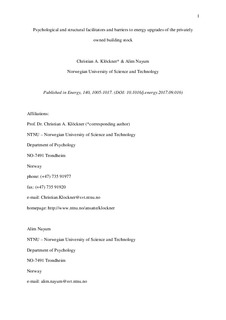| dc.contributor.author | Kløckner, Christian | |
| dc.contributor.author | Nayum, Alim | |
| dc.date.accessioned | 2018-04-30T11:11:12Z | |
| dc.date.available | 2018-04-30T11:11:12Z | |
| dc.date.created | 2017-09-27T15:26:49Z | |
| dc.date.issued | 2017 | |
| dc.identifier.citation | Energy. 2017, 140 1005-1017. | nb_NO |
| dc.identifier.issn | 0360-5442 | |
| dc.identifier.uri | http://hdl.handle.net/11250/2496524 | |
| dc.description.abstract | This article studies the psychological and structural determinants, barriers and drivers of the decision to upgrade the energy standard of privately owned residential buildings. A model is developed and tested on a sample of 2,687 Norwegian house owners. The intention to include energy efficiency upgrades in a rehabilitation project is determined by feelings of moral obligation to act, attitudes, and self-efficacy. The model shows also how these variables are linked to distal psychological variables like innovativeness, perceived consumer effectiveness, social norms, problem awareness, and value orientations. The impacts of structural barriers are channeled through the psychological variables. Important barriers are a feeling that the right time has not come yet to start the rehabilitation project, and being unsure about the economic saving potential. Important drivers are better living conditions in the dwelling and higher expected comfort, reduced energy costs and an increased market value of the dwelling, and perceiving the current building standard as a waste of energy. Limited economic resources seem to make people more interested in energy efficiency upgrades. Implications for policy-making are discussed. | nb_NO |
| dc.language.iso | eng | nb_NO |
| dc.publisher | Elsevier | nb_NO |
| dc.rights | Attribution-NonCommercial-NoDerivatives 4.0 Internasjonal | * |
| dc.rights.uri | http://creativecommons.org/licenses/by-nc-nd/4.0/deed.no | * |
| dc.title | Psychological and structural facilitators and barriers to energy upgrades of the privately owned building stock | nb_NO |
| dc.type | Journal article | nb_NO |
| dc.type | Peer reviewed | nb_NO |
| dc.description.version | acceptedVersion | nb_NO |
| dc.source.pagenumber | 1005-1017 | nb_NO |
| dc.source.volume | 140 | nb_NO |
| dc.source.journal | Energy | nb_NO |
| dc.identifier.doi | 10.1016/j.energy.2017.09.016 | |
| dc.identifier.cristin | 1499045 | |
| dc.relation.project | ENOVA SF: SID 09/1914 | nb_NO |
| dc.description.localcode | © 2017. This is the authors’ accepted and refereed manuscript to the article. Locked until 6.9.2019 due to copyright restrictions. This manuscript version is made available under the CC-BY-NC-ND 4.0 license http://creativecommons.org/licenses/by-nc-nd/4.0/ | nb_NO |
| cristin.unitcode | 194,67,40,0 | |
| cristin.unitname | Institutt for psykologi | |
| cristin.ispublished | true | |
| cristin.fulltext | postprint | |
| cristin.qualitycode | 2 | |

